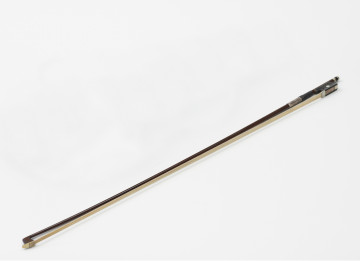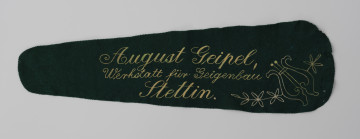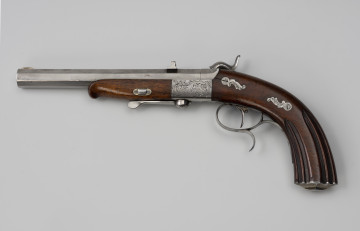
Violin bow
około 1900
National Museum in Szczecin
Part of the collections: Craft and industry products of Szczecin, Music instruments
Common during the Baroque period, the violin was based on earlier instruments such as the fiddle, lyre da braccio, or gusle, and some researchers trace its origins to Poland. Today, luthiers are still involved in the production of violins, handcrafting, repairing, and servicing not only string instruments, of which viola da gamba, hurdy-gurdy, Polish fiddle (polnische Geige), and gusle are less well-known examples, but also plucked string instruments such as lutes, mandolins, and guitars. Some of the most renowned workshops were founded in Italy, France and Germany, where entire families specialising in lutherie handed down the secrets of making the finest stringed instruments from generation to generation. A traditional violin consists of a neck crowned with a characteristic snail curl and two slightly convex plates forming the soundboard, with the top plate usually made of spruce wood and the bottom one of sycamore. A featured violin from the collection of the National Museum in Szczecin meets the same standards. This is a full-sized 4/4 violin, constructed following the model of the Italian luthier, by some researchers believed to be the inventor of the modern violin, Gaspar da Solo (1540-1609). A stamped inscription inside the sound box reveals the following: Gasparò da Salò, in Brescia. The instrument was made around 1900 in the August Geipel violin-making workshop, located at Grosse Wollweberstrasse 25 (now ul. Tkacka) in Szczecin. The family-owned business, founded in 1875, produced musical instruments such as violins and violin-related instruments (violas, cellos, double basses) until 1945. Małgorzata Peszko
Author / creator
Object type
violin
Technique
luthier techniques
Material
silver, spruce wood, wavy sycamore, ebony
Origin / acquisition method
donation
Creation time / dating
Creation / finding place
Owner
Muzeum Narodowe w Szczecinie
Identification number
Location / status

około 1900
National Museum in Szczecin

około 1900
National Museum in Szczecin

circa 1848 — 1860
National Museum in Szczecin
DISCOVER this TOPIC
Museum of King Jan III's Palace at Wilanów
DISCOVER this PATH
Educational path